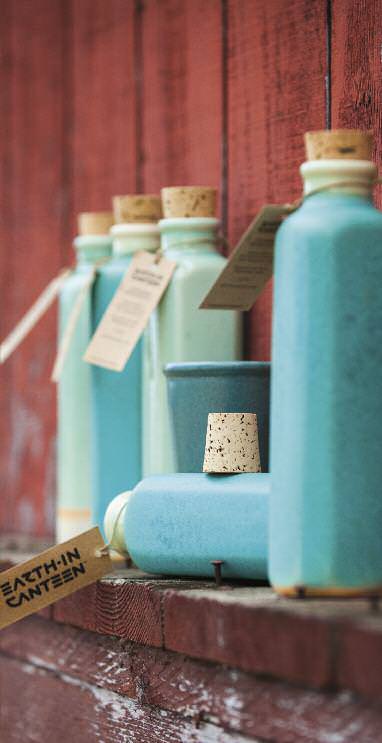edible notables
STONEWARE SUSTAINABILITY
Earth-In Canteens are natural, beautiful, and local.
WRITTEN BY ERIN MEYERING
PHOTOS BY CHRIS HOLLOMAN
Keys? Check. Phone? Check. Water bottle? Check.
Carrying a reusable water bottle has become second nature to most. Whether you’re on your way to work, the gym, or a lunch date, it’s likely to be part of your normal routine.
Employing a reusable water bottle is not only cool to do, but it also can save precious resources. According to the Pacific Institute, a global water think tank, it takes three times the volume of water to manufacture one plastic bottle of water than it does to fill it.
Kathy and Richard Staychock helped found Klean Kanteen, a company that manufactures stainless-steel bottles. They say that in 2003, they set out to create a new kind of sustainably sourced and ethically produced bottle. They put their efforts and lessons from past experience into Earth-In Canteen, a stoneware bottle company they launched in 2014 at Earth Day festivals in Berkeley and San Francisco. The company now is based in Stateline, Nev.

The Staychocks say that while many business owners outsource their manufacturing processes to overseas companies to cut costs, among other reasons, their main goal was to produce their bottles in the United States. This was important to them because it would allow them to have proper oversight of work conditions, materials, and production processes.
“You can justify almost anything,” Kathy says, “but we wanted to be transparent.”
In addition, Kathy says, many of her previous customers and retailers would complain about a harsh metallic taste after drinking out of stainless-steel water bottles. Kathy says that it’s hard to properly treat the inside of a stainless-steel container. Avoiding this aftertaste was a primary reason for the Staychocks to change direction and create ceramic bottles.
The Staychocks insist that the key to the charming bottles is proper area sourcing and a talented ceramicist. Cue Hector Sedano, a fourth-generation ceramicist.
Working outside of his studio just north of Red Bluff, Calif., Sedano starts with clay sourced from California. He then uses lead-free glazes mixed in the Berkeley area. The finishing touch? A sturdy cap, made from sustainable cork harvested in cork-oak forests in Portugal.
Each bottle weighs about one pound, and although ceramic may be a questionable material for everyday use and transport, Kathy says she bikes with hers routinely, and the cork stays tightly sealed.
Also, she says competitive production can be done locally. And doing so is important in countless ways. Plus, she adds, “It feels 100 percent better.”
Erin Meyering is the associate editor of edible Reno-Tahoe. She loves combining fashion with function and sustainability, so learning of Earth-In Canteen was a treat. Her favorite canteen color is Sky Blue, but ’70s Kitchen is a close second.
Earth-In Canteen
The ceramic bottles (and the new Earth-In pint cups) can be purchased through the company’s online store and at several distributors in California, Oregon, and Washington. For details, look for the store locator on http://www.earthincanteen.com


